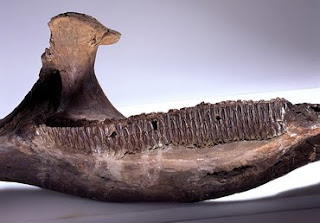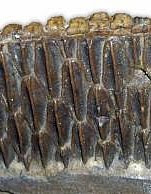
Hadrosaurs,the duck billed dinosaur could chew in a very unusual way.The scientists has this in the Proceedings of the National Academy of Sciences (PNAS) today.
Highly magnified scanning electron microscope view of surface of one of the hadrosaur teeth. The scratches are inside the boxes, which are less than 0.5mm in width. © Vince Williams, University of Leicester
Scientists, led by palaeontologist Mark Purnell of the University of Leicester, and including those from the Natural History Museum, discovered hadrosaurs had a unique way of eating, unlike any other creature alive.
Examining scratches
They examined tiny scratches on 67-million-year-old fossil teeth of an Edmontosaurus, a specimen from the Natural History Museum.
A different chew
The results showed the teeth movements were complex and involved up and down, sideways and front to back motion. Natural History Museum dinosaur fossil expert Paul Barrett explains.
Teeth from the lower jaw of a hadrosaur showing its multiple rows of leaf-shaped teeth. The worn, chewing surface of the teeth is towards the top. © Vince Williams, University of Leicester.
‘The results show that hadrosaurs did chew, but in a completely different way to anything alive today. As they bit down on their food the upper jaws were forced outwards, flexing along this hinge so that the tooth surfaces slid sideways across each other, grinding and shredding food in the process.’‘The lower jaws could also be moved back and forth, giving a second grinding action.’
What they ate
The research also sheds light on what the dinosaurs ate. Vince Williams of the University of Leicester says, ‘Although the first grasses had evolved by the Late Cretaceous they were not common and it is most unlikely that grasses formed a major component of hadrosaur diets.’

No comments:
Post a Comment